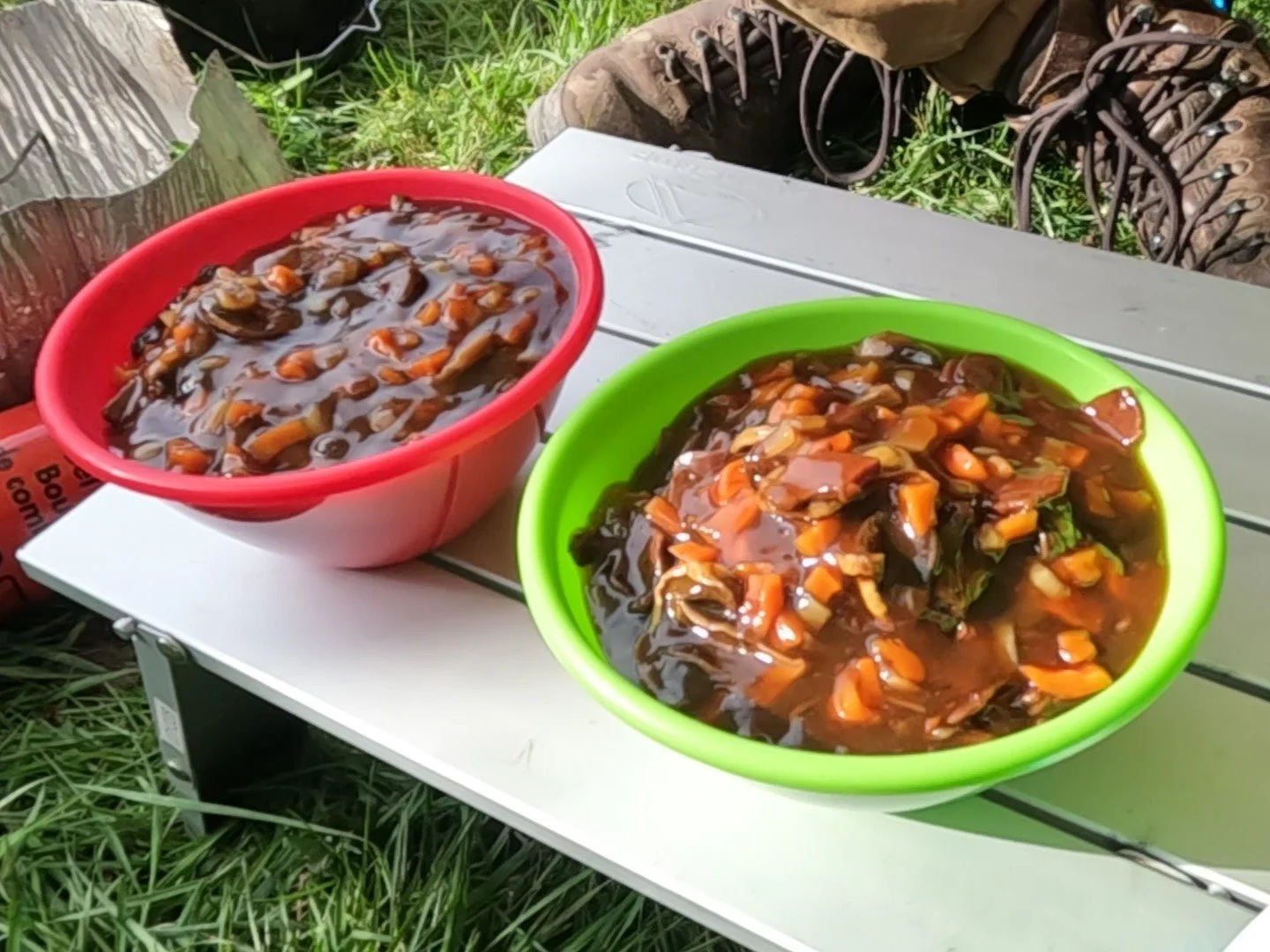Adventure Stew
In essence this is vegetables and protein in gravy. The key part is that the ingredients do not weigh much yet it feels satisfyingly heavy when you eat it. This stew can equally be cooked from dry ingredients found in most supermarkets as it can be from pre-adventure home dehydrated ingredients.
Ingredients
If you can get hold of the core ingredients it is possible to add as few or as many of the optional ingredients as you wish or can find.
Core ingredients
The core ingredients are a foundation of the liquid gravy and a protein.
Gravy granules - These not only add flavour but also have a thickening effect making sure your stew is not watery.
A dried protein of choice - We tend to lean towards jerky. If we are in the UK we will make a batch of black pepper and rosemary beef jerky. If you go for dried beans these may require additional cooking time.
Powdered potato - This just goes well with the stew. Fresh potatoes are heavy, take ages to cook, and don't travel well in a barrel or rucksack.
Clean water - As most of this dish is dried you are going to need a significant amount of water to make something that resembles a stew.
Optional Ingredients
Now this is where you can start experimenting. Some ingredient we have found that work well in this style of stews:
Onions - Fresh or dehydrated.
Carrots - Fresh or dehydrated.
Peas - Freeze dried as just dried takes too long to rehydrate.
Mushrooms - Dried works really well.
Bell peppers - Fresh or dehydrated.
Vegetable oil - If you are using fresh ingredients then a little oil can be helpful to fry the vegetables which cooks them quicker than boiling.
Salt and pepper - For final seasoning.
Cooking equipment
This is one that you can easily do in the wild.
Camping stove - Something that has a controllable heat is preferable. Although possible over a spirit burner it is a bit more of a challenge to not weld food to the bottom.
Large saucepan with lid- Large enough to hold the volume of food that you are looking to make.
Small Saucepan with lid - Only needs to be big enough to heat the water that you are going to need for the powdered potato.
Mixing spoon - We tend to use a large-ish wooden spoon.
Knife - Almost anything that has an edge on will do, though this is only needed if you are using fresh vegetables.
Cutting surface - Something that can be cut onto without damaging you or your knife blade, again only needed if you are using fresh vegetables.
Method
There are two parts to this recipe, one being the stew and the other being the potato. As we tend to only carry one stove we tend to make the stew first and let it sit while making the potato.
For the stew:
If you have fresh vegetables cut them into approximately 5mm (¼”) cubes. This may seem small, but the larger you dice them the longer they’ll take to cook.
Shred your jerky into pieces, the size of a 10p piece (or a US quarter) is pretty good.
If you are using fresh vegetables, start with putting a drop of oil into the large saucepan, add the vegetables and fry until soft.
Add all your dry vegetables into the large pan with enough water to cover them, plus a bit. The dry vegetables will soak up most of the water covering them, and the extra bit will end up being your stew liquid, so add as much or as little as you want.
Bring to a simmer and keep stirring until the point where the vegetables are just getting soft.
Add the jerky and wait until it has rehydrated to your desired level. If you time it right the vegetables are all soft and the jerky is flakey.
Add the gravy granules and stir. This will quickly thicken the liquid. You may or may not need to add a little water at this point depending on your desired consistency. One thing to note: as the stew cools it will get thicker.
For the powdered potato:
This is going to sound like a cop out, but using the smaller saucepan follow the instructions on the packet. We’ve tried a fair few brands, and the amount of water they ask for usually produces an acceptable consistency of mashed potato.
Season if you think it’s necessary.
Combine the stew and potato to enjoy.
Trail tips
If we have a flask with us then we tend to start all meals by boiling water and filling the flask. This hot water can be used for the stew and the potato if you then want to speed up later steps.
Depending on our days we will consider how much water to add. If cold we may add more water to aid in our hydration levels. If it is very warm we may use less water to avoid putting more heat into our bodies.
We have had fun playing with the flavours of jerky we have used. We have found that this recipe works just as well with the few vegan jerky options we’ve tried too. However a word of warning on this one, some of the vegan jerky will just disintegrate, and others don't actually have that much protein in as they are intended for snacking.
Depending on the dried protein you are using depends on how much moisture it has in it and hence when best time to add to the water.

